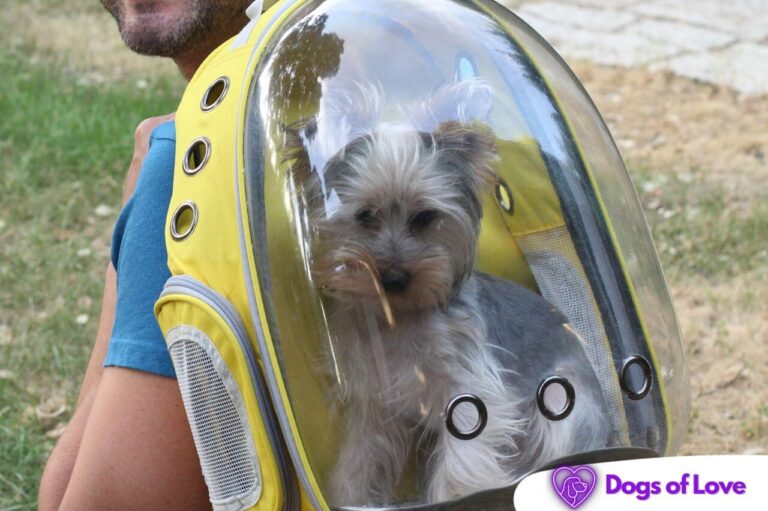The question of how long a dog can stay in a carrier is a vital consideration for responsible pet owners.
Just as humans have their limits for sitting or staying in confined spaces, dogs, too, have their thresholds for comfort, well-being, and safety within a carrier.
Understanding these limitations is essential for providing your furry companion with a positive travel or confinement experience.
This inquiry delves into the factors that influence the duration a dog can stay in a carrier, shedding light on the importance of balancing convenience with your dog’s physical and emotional needs.
By exploring this topic, you can make informed decisions to ensure your dog’s health, happiness, and overall welfare during confinement or travel.

How Long is Too Long for a Dog to Be in a Carrier?
The recommended duration for a dog to be in a carrier generally ranges from up to 6 hours, with a maximum of 8 hours considered acceptable.
Staying within this timeframe ensures your dog’s safety and comfort during confinement.
It’s important to remember that each dog is unique, and factors such as age, size, temperament, and travel conditions should be considered.
If you anticipate a more extended period of confinement, it’s advisable to plan for breaks where your dog can stretch, move around, and relieve themselves.
Prioritizing your dog’s needs and well-being ensures a positive experience while using a carrier for various activities, whether travel, outings, or trips to the veterinarian.
What are the Benefits of Using Carriers for Dogs?
Using carriers for dogs offers a range of valuable benefits that cater to both the well-being of your pet and the convenience of pet owners.
Carriers provide a safe and secure space for your dog during travel, helping to reduce anxiety and stress associated with unfamiliar environments.
They also serve as a comfortable and familiar sanctuary where your dog can retreat and relax, even in crowded or noisy settings.
Carriers enable pet owners to easily transport their dogs while ensuring their safety, especially in busy areas or during activities where leashes may not be practical.
Additionally, carriers are essential for veterinarians or other appointments, ensuring a contained and controlled environment for your dog’s well-being.
Ultimately, carriers contribute to a smoother and more enjoyable travel experience, enhance the bond between pet and owner, and offer peace of mind by prioritizing the safety and comfort of your furry friend.
What Kinds of Carriers Are Safe for Dogs?
When selecting safe carriers for dogs, there are two main options based on your pet’s size and temperament.
Soft pet carriers, typically constructed from flexible nylon, are well-suited for smaller pets. These carriers offer a snug and cozy environment akin to a nest, providing comfort and security for your furry companion.
On the contrary, hard-sided plastic carriers are a suitable choice for larger or more active dogs.
These carriers provide enhanced protection due to their sturdy construction and are particularly well-suited to pets that may be more rambunctious during travel.
By choosing the appropriate carrier type based on your dog’s characteristics, you can ensure their safety and comfort while on the move.
How to Measure the Comfort and Safety of a Dog Carrier?
Measuring the comfort and safety of a dog carrier involves thoroughly evaluating various factors to ensure a positive travel experience for your furry friend.
Begin by assessing the carrier’s size – it should provide ample room for your dog to turn around, stand, and lie down comfortably.
Check for ventilation features like mesh windows to ensure proper airflow and prevent overheating.
Look for secure fastenings, such as sturdy zippers or clasps, to prevent accidental openings during travel.
Consider the carrier’s construction material; soft carriers offer flexibility and coziness, while hard-sided carriers provide extra protection.
Examine the carrier’s weight-bearing capacity to ensure it can safely accommodate your pet’s size.
Additionally, assess any padding or cushioning for comfort and make sure there are no sharp edges or protrusions that could cause discomfort.
By meticulously evaluating these elements, you can gauge the comfort and safety of a dog carrier and make an informed choice that prioritizes your pet’s well-being during journeys or outings.
What are the Safety Guidelines for Keeping Your Dog in a Carrier?
Safety guidelines for keeping your dog in a carrier encompass several crucial considerations to ensure their well-being and comfort.
Firstly, ensure the carrier’s size is appropriate, offering enough space for your dog to move, stand, and lie comfortably.
Secure your pet within the carrier using a well-fitting harness or collar to prevent escapes. Check for proper ventilation to maintain airflow, prevent overheating, and avoid exposing your dog to extreme temperatures.
Ensure the carrier is stable and won’t tip over, especially if placed on a vehicle seat. Keep the carrier well-ventilated and avoid placing it in direct sunlight.
Always place the carrier securely, preventing any jostling during travel. Regularly check the carrier for any signs of wear, such as frayed straps or loose seams, and promptly address any issues.
By adhering to these safety guidelines, you can provide a secure and comfortable environment for your dog while in the carrier, whether on a short trip to the vet or embarking on a more extended journey.
Tips on Making Your Dog’s Carrier Time More Enjoyable
Making your dog’s time in the carrier more enjoyable involves a combination of thoughtful preparation and positive reinforcement.
Begin by gradually acclimating your dog to the carrier through positive associations, such as placing treats, toys, or a familiar blanket inside.
Incorporate short practice sessions where your dog enters the carrier willingly, rewarding them with treats and praise.
Use the carrier for positive experiences like feeding meals or engaging in playtime, fostering a sense of comfort and familiarity.
Ensure the carrier is always clean, cozy, and well-ventilated to create an inviting space.
Offer reassurance and soothing words to alleviate anxiety, and consider using calming products like pheromone sprays or essential oils if your dog is particularly anxious.
Regularly engage in short trips or outings using the carrier, gradually increasing the duration to build your dog’s tolerance.
By following these tips, you can transform the carrier into a place of comfort, security, and positive associations, making your dog’s time more enjoyable and stress-free.
In conclusion
Understanding the appropriate duration for a dog to stay in a carrier is essential for maintaining their well-being and ensuring a positive travel or confinement experience.
While the recommended timeframe generally ranges from up to 6 hours, with a maximum of 8 hours being acceptable, it’s crucial to consider your dog’s needs, size, temperament, and the circumstances surrounding their confinement.
Prioritizing regular breaks for stretching, movement, and bathroom breaks during more extended career time helps prevent discomfort and stress.
Striking a balance between practicality and your dog’s comfort is vital to fostering a positive relationship with the carrier and minimizing potential adverse effects.
By adhering to these guidelines and consistently prioritizing your dog’s needs, you can create a safe and enjoyable environment within the carrier, ensuring your furry companion’s well-being while moving.








